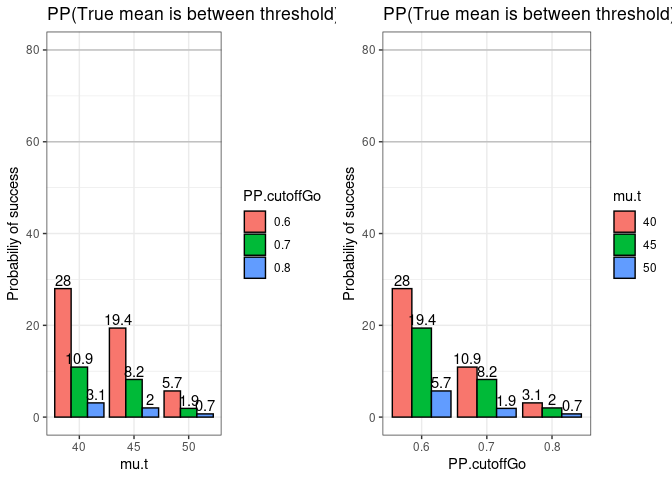GoNoGo
The goal of GoNoGo is to provide the posterior probability and
operating characteristics of Bayesian Go/No-Go decision-making based on
specific model assumptions. Currently, it specifically covers scenarios
involving single normal mean, two independent normal mean differences,
and two independent normal mean ratio analysis, considering both
informative and non-informative priors. For a more in-depth
understanding of the technical aspects, please refer to the Vignette.
Dependencies
GoNoGo requires the following R package: devtools (for
installation only). Please install it before installing GoNoGo, which
can be done as follows (execute from within a fresh R session):
install.packages("devtools")
library(devtools)Installation
Once the dependencies are installed, GonoGo can be loaded using the
following command:
devtools::install_github("Merck/GoNoGo")
library(GoNoGo)Scenarios (In current version)
- Operating characteristics
- Normal 1 sample - Prior: non-informative - Hypothesis: greater than, less than, between
- Normal 1 sample - Prior: informative - Hypothesis: greater than, less than, between
- Normal 2 sample - Difference/ratio - Prior: non-informative - Hypothesis: greater than, less than, between
- Normal 2 sample - Difference/ratio - Prior: informative - Hypothesis: greater than, less than, between
- Posterior probability
- Normal 1 sample - Prior: non-informative - Hypothesis: greater than, less than, between
- Normal 1 sample - Prior: informative - Hypothesis: greater than, less than, between
- Normal 2 sample - Difference/ratio - Prior: non-informative - Hypothesis: greater than, less than, between
- Normal 2 sample - Difference/ratio - Prior: informative - Hypothesis: greater than, less than, between
- Plot
Example 1 (Operating characterstics)
This is a basic example which shows you how to generate operating characteristics for a normal one sample non-informative prior with hypothesis = “greater than”:
##################
# Load libraries #
##################
library(GoNoGo)
library(ggplot2)
library(grid)
library(gridExtra)
n.t = rep(8, 9) # Sample size in treatment arm
mu.t = rep(c(40, 45, 50), each = 3) # True mean of the treatment arm
sd.t = rep(15, 9) # True sd of the treatment arm
hypothesis = "between" # "greater than", "less than", "between"
threshold = matrix(rep(c(35, 45), each = 9), ncol = 2) # k: Target region cut-off
PP.cutoffGo = rep(c(0.6, 0.7, 0.8), 3) # c1: Cut-off for probability of Go
PP.cutoffNoGo = rep(c(0.6, 0.7, 0.8), 3) # c2: Cut-off for probability of No-Go
prior = "non-informative" # Prior choice
reps = 1000 # Number of repetitions for samples from the posterior using simulation
nsim = 1000 # Number of simulations
set.seed(1234)
pos.val = vector("list", length(n.t))
for(i in 1:length(n.t)){
pos.val[[i]] = Normal1SampleGNG(n.t = n.t[i], mu.t = mu.t[i], sd.t = sd.t[i],
hypothesis = hypothesis, threshold = threshold[i,],
PP.cutoffGo = PP.cutoffGo[i],
PP.cutoffNoGo = PP.cutoffNoGo[i],
nsim = nsim, reps = reps)$pos
}
data = dataoutput(prob.val = pos.val)
data$mu.t = unlist(data$mu.t)
data$PP.cutoffGo = unlist(data$ PP.cutoffGo)
data$mu.t = as.factor(data$mu.t)
data$PP.cutoffGo = as.factor(data$ PP.cutoffGo)
data
#> n.t mu.t sd.t threshold PP.cutoffGo PP.cutoffNoGo hypothesis
#> 1 8 40 15 ( 35 , 45 ) 0.6 0.6 between
#> 2 8 40 15 ( 35 , 45 ) 0.7 0.7 between
#> 3 8 40 15 ( 35 , 45 ) 0.8 0.8 between
#> 4 8 45 15 ( 35 , 45 ) 0.6 0.6 between
#> 5 8 45 15 ( 35 , 45 ) 0.7 0.7 between
#> 6 8 45 15 ( 35 , 45 ) 0.8 0.8 between
#> 7 8 50 15 ( 35 , 45 ) 0.6 0.6 between
#> 8 8 50 15 ( 35 , 45 ) 0.7 0.7 between
#> 9 8 50 15 ( 35 , 45 ) 0.8 0.8 between
#> prior nsim reps time probGo probNoGo
#> 1 non-informative 1000 1000 0.7117572 28.0 72.0
#> 2 non-informative 1000 1000 0.6791127 10.9 89.1
#> 3 non-informative 1000 1000 0.6783869 3.1 96.9
#> 4 non-informative 1000 1000 0.6788502 19.4 80.6
#> 5 non-informative 1000 1000 0.7581697 8.2 91.8
#> 6 non-informative 1000 1000 0.6835802 2.0 98.0
#> 7 non-informative 1000 1000 0.6700401 5.7 94.3
#> 8 non-informative 1000 1000 0.6826077 1.9 98.1
#> 9 non-informative 1000 1000 0.7465584 0.7 99.3p1 = GNGplot(data = data, x.var = data$mu.t,
fill.var = data$PP.cutoffGo,
hypothesis = data$hypothesis,
x.lab = "mu.t",
title.text = paste("PP(True mean is", hypothesis,
"threshold) >= PP cutoff"),
legend.title.text = "PP.cutoffGo")
p2 = GNGplot(data = data, x.var = data$PP.cutoffGo,
fill.var = data$mu.t,
hypothesis = data$hypothesis,
x.lab = "PP.cutoffGo",
title.text = paste("PP(True mean is", hypothesis,
"threshold) >= PP cutoff"),
legend.title.text = "mu.t" )
grid.arrange(p1, p2, nrow = 1)Example 2 (Posterior probability)
This is a basic example which shows you how to generate posterior probability based on the previous parameters.
set.seed(1234)
pp.val = vector("list", length(n.t))
for(i in 1:length(n.t)){
pp.val[[i]] = Normal1SamplePP(n.t = n.t[i], mu.t = mu.t[i], sd.t = sd.t[i],
hypothesis = hypothesis,
threshold = threshold[i,], prior = prior,
PP.cutoffGo = PP.cutoffGo[i],
PP.cutoffNoGo = PP.cutoffNoGo[i], reps = reps)
}
posterior.prob = dataoutput(prob.val = pp.val, output.format = "PP")
posterior.prob
#> n.t mu.t sd.t threshold PP.cutoffGo PP.cutoffNoGo hypothesis
#> 1 8 40 15 ( 35 , 45 ) 0.6 0.6 between
#> 2 8 40 15 ( 35 , 45 ) 0.7 0.7 between
#> 3 8 40 15 ( 35 , 45 ) 0.8 0.8 between
#> 4 8 45 15 ( 35 , 45 ) 0.6 0.6 between
#> 5 8 45 15 ( 35 , 45 ) 0.7 0.7 between
#> 6 8 45 15 ( 35 , 45 ) 0.8 0.8 between
#> 7 8 50 15 ( 35 , 45 ) 0.6 0.6 between
#> 8 8 50 15 ( 35 , 45 ) 0.7 0.7 between
#> 9 8 50 15 ( 35 , 45 ) 0.8 0.8 between
#> prior reps time pp
#> 1 non-informative 1000 0.0006725788 0.622
#> 2 non-informative 1000 0.000648737 0.621
#> 3 non-informative 1000 0.0006375313 0.641
#> 4 non-informative 1000 0.0006489754 0.424
#> 5 non-informative 1000 0.0006213188 0.453
#> 6 non-informative 1000 0.0006527901 0.466
#> 7 non-informative 1000 0.0006437302 0.205
#> 8 non-informative 1000 0.0006444454 0.180
#> 9 non-informative 1000 0.0006220341 0.164Work in progress
Currently, the followings are in progress
- R-shiny app corresponding to Normal
- Binary Go/No-Go.
